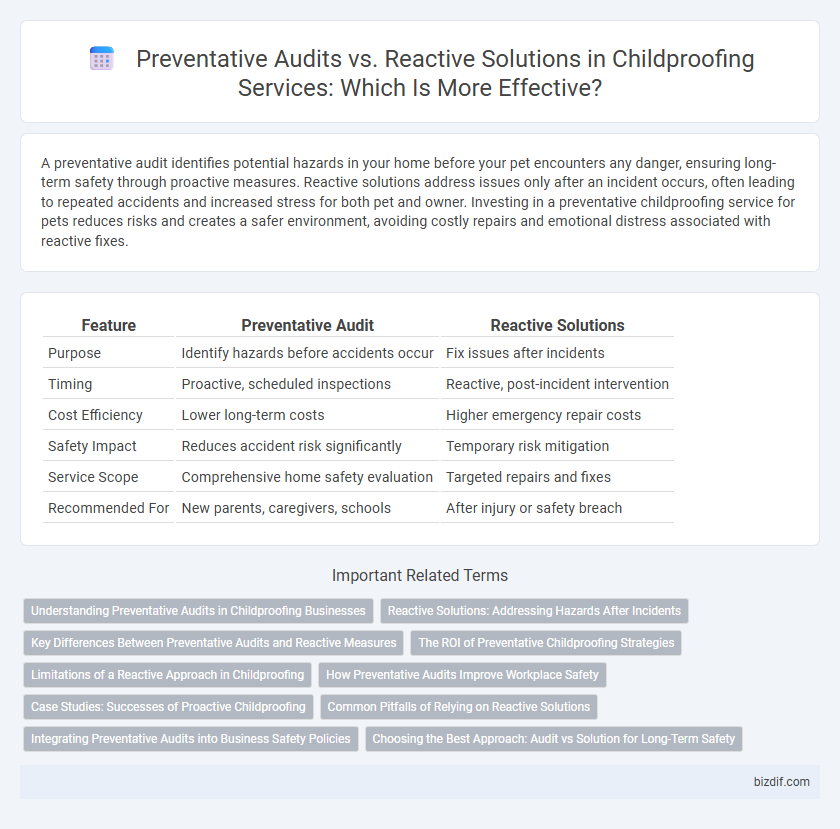A preventative audit identifies potential hazards in your home before your pet encounters any danger, ensuring long-term safety through proactive measures. Reactive solutions address issues only after an incident occurs, often leading to repeated accidents and increased stress for both pet and owner. Investing in a preventative childproofing service for pets reduces risks and creates a safer environment, avoiding costly repairs and emotional distress associated with reactive fixes.
Table of Comparison
| Feature | Preventative Audit | Reactive Solutions |
|---|---|---|
| Purpose | Identify hazards before accidents occur | Fix issues after incidents |
| Timing | Proactive, scheduled inspections | Reactive, post-incident intervention |
| Cost Efficiency | Lower long-term costs | Higher emergency repair costs |
| Safety Impact | Reduces accident risk significantly | Temporary risk mitigation |
| Service Scope | Comprehensive home safety evaluation | Targeted repairs and fixes |
| Recommended For | New parents, caregivers, schools | After injury or safety breach |
Understanding Preventative Audits in Childproofing Businesses
Preventative audits in childproofing businesses involve thorough inspections to identify potential hazards before accidents occur, ensuring a safer environment for children. These proactive assessments evaluate furniture, electrical outlets, and access points to recommend effective safety measures tailored to each space. Implementing preventative audits reduces the need for costly reactive solutions by addressing risks early and enhancing overall child safety compliance.
Reactive Solutions: Addressing Hazards After Incidents
Reactive solutions focus on addressing hazards after incidents occur, offering immediate repairs and safety improvements to prevent future accidents. These interventions often involve emergency fixes and corrective measures based on actual damage or near-misses, rather than proactive assessment. While necessary for urgent risk mitigation, reactive responses may lack the comprehensive foresight that preventative audits provide in childproofing environments.
Key Differences Between Preventative Audits and Reactive Measures
Preventative audits in childproofing involve proactive assessments to identify and eliminate potential hazards before accidents occur, reducing risk and enhancing safety in the home environment. Reactive solutions address issues only after an incident or near-miss, often leading to higher costs and increased danger during the interim period. The key difference lies in timing and approach: preventative audits emphasize early detection and continuous safety improvements, whereas reactive measures focus on fixing problems post-occurrence.
The ROI of Preventative Childproofing Strategies
Preventative childproofing audits identify potential hazards before accidents occur, significantly reducing the risk of injuries and costly medical bills. Investing in proactive safety measures leads to long-term savings by minimizing emergency repairs and liability claims associated with reactive solutions. Businesses and homes benefit from improved safety compliance and peace of mind, maximizing the return on investment through reduced downtime and enhanced protection for children.
Limitations of a Reactive Approach in Childproofing
Reactive solutions in childproofing often address hazards only after an incident occurs, lacking comprehensive risk assessment and continuous safety measures. This approach can leave critical dangers unnoticed, increasing the potential for injury despite temporary fixes. Preventative audits systematically identify and mitigate risks proactively, ensuring a safer environment for children by targeting vulnerabilities before accidents happen.
How Preventative Audits Improve Workplace Safety
Preventative audits systematically identify potential hazards before incidents occur, significantly reducing workplace accidents and enhancing overall safety standards. These audits provide actionable insights through comprehensive risk assessments, enabling organizations to implement effective childproofing measures proactively. Implementing preventative audits leads to sustained compliance with safety regulations and fosters a safer environment for employees and children alike.
Case Studies: Successes of Proactive Childproofing
Case studies reveal that preventative audits in childproofing significantly reduce accidents by identifying hazards before incidents occur, outperforming reactive solutions that address dangers post-injury. Homes with proactive childproofing audits report a 70% decrease in emergency visits due to preventable injuries, showcasing the effectiveness of early intervention. Data from multiple families highlights improved safety outcomes and peace of mind when risks are mitigated through comprehensive audits rather than reactive fixes.
Common Pitfalls of Relying on Reactive Solutions
Relying on reactive childproofing solutions often leads to common pitfalls such as delayed hazard identification and increased risk of accidents, as issues are addressed only after an incident occurs. Preventative audits systematically assess potential dangers before they cause harm, ensuring a safer environment for children. This proactive approach reduces emergency interventions and promotes long-term safety by anticipating and mitigating risks early.
Integrating Preventative Audits into Business Safety Policies
Integrating preventative audits into business safety policies enhances childproofing effectiveness by identifying potential hazards before incidents occur, reducing liability and improving compliance with safety regulations. Preventative audits provide actionable insights that support continuous improvement, minimizing risks through proactive measures rather than relying on costly reactive solutions after accidents. Embedding these audits into routine safety protocols fosters a culture of vigilance, ensuring ongoing protection for children in business environments.
Choosing the Best Approach: Audit vs Solution for Long-Term Safety
Choosing a preventative audit over reactive solutions ensures comprehensive identification and mitigation of potential hazards before accidents occur, significantly reducing the risk of injury. Preventative audits analyze the entire environment, enabling tailored childproofing strategies that address hidden dangers and compliance with safety standards. Reactive solutions address existing problems but may overlook underlying risks, making audits the superior choice for sustainable, long-term child safety.
Preventative Audit vs Reactive Solutions Infographic

 bizdif.com
bizdif.com